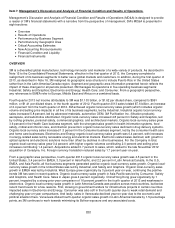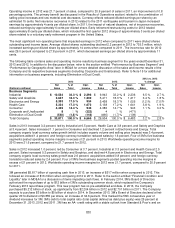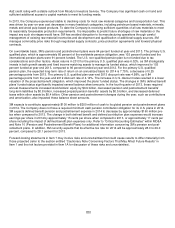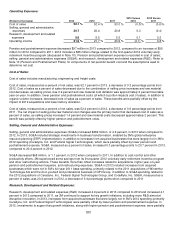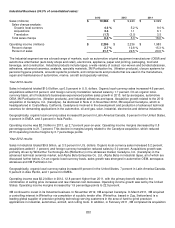3M 2013 Annual Report Download - page 24
Download and view the complete annual report
Please find page 24 of the 2013 3M annual report below. You can navigate through the pages in the report by either clicking on the pages listed below, or by using the keyword search tool below to find specific information within the annual report.18
Aa2 credit rating with a stable outlook from Moody’s Investors Service. The Company has significant cash on hand and
sufficient additional access to capital markets to meet its funding needs.
In 2013, the Company experienced stable to declining costs for most raw material categories and transportation fuel. This
was driven by year-on-year cost decreases in many feedstock categories, including petroleum based materials, minerals,
metals and wood pulp based products. To date the Company is receiving sufficient quantities of all raw materials to meet
its reasonably foreseeable production requirements. It is impossible to predict future shortages of raw materials or the
impact any such shortages would have. 3M has avoided disruption to its manufacturing operations through careful
management of existing raw material inventories and development and qualification of additional supply sources. 3M
manages commodity price risks through negotiated supply contracts, price protection agreements and forward physical
contracts.
On a worldwide basis, 3M’s pension and postretirement plans were 94 percent funded at year-end 2013. The primary U.S.
qualified plan, which is approximately 66 percent of the worldwide pension obligation, was 103 percent funded and the
international pension plans were 91 percent funded. The U.S. non-qualified pension plan is not funded due to tax
considerations and other factors. Asset returns in 2013 for the primary U.S. qualified plan was 6.02%, as 3M strategically
invests in both growth assets and fixed income matching assets to manage its funded status, which improved to 103
percent funded at year-end 2013, compared to 96 percent funded at year-end 2012. For the primary U.S. qualified
pension plan, the expected long-term rate of return on an annualized basis for 2014 is 7.75%, a decrease of 0.25
percentage points from 2013. The primary U.S. qualified plan year-end 2013 discount rate was 4.98%, up 0.84
percentage points from the year-end 2012 discount rate of 4.14%. The increase in U.S. discount rates resulted in a lower
valuation of the projected benefit obligation, which improved the plans’ funded status. The changes in 3M’s defined benefit
plans’ funded status significantly impacted several balance sheet amounts. In the fourth-quarter of 2013, these required
annual measurements increased stockholders’ equity by $0.9 billion, decreased pension and postretirement benefits’
long-term liabilities by $0.8 billion, increased prepaid pension benefits’ assets by $0.5 billion, and decreased deferred
taxes within other assets by $0.4 billion. Other pension and postretirement changes during the year, such as contributions
and amortization, also impacted these balance sheet amounts.
3M expects to contribute approximately $100 million to $200 million of cash to its global pension and postretirement plans
in 2014. The Company does not have a required minimum cash pension contribution obligation for its U.S. plans in 2014.
3M expects defined benefit pension and postretirement expense in 2014 to decrease by approximately $160 million pre-
tax when compared to 2013. The change in both defined benefit and defined contribution plan expenses would increase
earnings per share in 2014 by approximately 15 cents per share when compared to 2013, or approximately 17 cents per
share including the impact of defined benefit plan expenses only. Refer to “Critical Accounting Estimates” within MD&A
and Note 10 (Pension and Postretirement Benefit Plans) for additional information concerning 3M’s pension and post-
retirement plans. In addition, 3M currently expects that its effective tax rate for 2014 will be approximately 28.0 to 29.0
percent, compared to 28.1 percent for 2013.
Forward-looking statements in Item 7 may involve risks and uncertainties that could cause results to differ materially from
those projected (refer to the section entitled “Cautionary Note Concerning Factors That May Affect Future Results” in
Item 1 and the risk factors provided in Item 1A for discussion of these risks and uncertainties).









